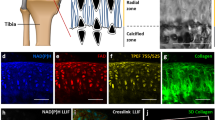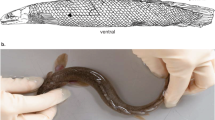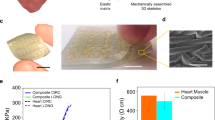Abstract
Owing to the similarity to biological tissues, soft materials have attracted increasing attention as components of biological tissues. However, there is a large difference between synthetic soft materials and biological tissues. Most synthetic soft materials are structurally isotropic, whereas some biological tissues have anisotropic structures that continue over a macroscopic size scale. As seen in muscle, blood vessels, articular cartilage, and iridophores, such anisotropic structures often play critical roles in producing their superb functions. Thus, the control of “structural anisotropy” is a key concept for the further exploration of functional soft materials science. Using the magnetic orientation of nanoobjects in a colloidal dispersion and subsequent in situ polymerization, we recently succeeded in developing anisotropic soft materials, in which highly oriented structures (order parameter = > 0.95) extend over a macroscopic size scale (~10 cm). In addition, we demonstrated unprecedented unique functions of the resultant materials, including ultralarge mechanical anisotropy similar to articular cartilage, quick and large deformation similar to muscular tissues, and dynamic structural color modulation similar to the skin of tropical fish. Integration of the related studies on soft materials with anisotropically oriented structures would bring the concepts of artificial organs and soft robotics into reality.
Similar content being viewed by others
Log in or create a free account to read this content
Gain free access to this article, as well as selected content from this journal and more on nature.com
or
References
Peppas NA, Hilt JZ, Khademhosseini A, Langer R. Hydrogels in biology and medicine: from molecular principles to bionanotechnology. Adv Mater. 2006;18:1345–60.
Slaughter BV, Khurshid SS, Fisher OZ, Khademhosseini A, Peppas NA. Hydrogels in regenerative medicine. Adv Mater. 2009;21:3307–29.
Freymann G, Kitaev V, Lotschzc BV, Ozin GA. Bottom-up assembly of photonic crystals. Chem Soc Rev. 2013;42:2528–54.
Bisoyi HK, Kumar S. Liquid-crystal nanoscience: an emerging avenue of soft self-assembly. Chem Soc Rev. 2011;40:306–19.
Huxley HE. The mechanism of muscular contraction. Science. 1969;164:1356–65.
Weber A, Murray JM. Molecular control mechanisms in muscle contraction. Physiol Rev. 1973;53:612–73.
Bazzoni G, Dejana E. Endothelial cell-to-cell junctions: molecular organization and role in vascular homeostasis. Physiol Rev. 2004;84:869–901.
Fox AJS, Bedi A, Rodeo SA. The basic science of articular cartilage: structure, composition, and function. Sports Health. 2009;1:461–8.
Poole AR, Kojima T, Yasuda T, Mwale F, Kobayashi M, Laverty S. Composition and structure of articular cartilage. Clin Orthop Relat Res. 2001;391:S26–33.
Fujii R. The regulation of motile activity in fish chromatophores. Pigment Cell Res. 2000;13:300–19.
Ginger ML, Portman N, McKean PG. Swiming with protists: perception, motility and flagellum assembly. Nat Rev Microbiol. 2008;6:838–50.
Quillin KJ. Kinematic scaling of locomotion by hydrostatic animals: ontogeny of peristaltic crawling by the earthworm Lumbricus terrestris. J Exp Biol. 1999;202:661–74.
Franze K, Grosche J, Skatchkov SN, Schinkinger S, Foja C, Schild D et al. Müller cells are living optical fibers in the vertebrate retina. Proc Natl Acad Sci USA. 2007;104:8287–92.
Pachence JM. Collagen-based devices for soft tissue repair. J Biomed Mater Res Part A. 1996;33:35–40.
Yang SH, Chung WJ, McFarland S, Lee SW. Assembly of bacteriophage into functional materials. Chem Rec. 2013;13:43–59.
Chaterji S, Kwon IK, Park K. Smart polymeric gels: redefining the limits of biomedical devices. Prog Polym Sci. 2007;32:1083–112.
Lau WJ, Gray S, Matsuura T, Emadzadeh D, Chen JP, Ismail AF. A review on polyamide thin film nanocomposite (TFN) membranes: history, applications, challenges and approaches. Water Res. 2015;80:306–24.
Liu Y, Xu Z, Gao W, Cheng Z, Gao C. Graphene and other 2D colloids: liquid crystals and macroscopic fibers. Adv Mater. 2017;29:1606794.
Buck MR, Schaak RE. Emerging strategies for the total synthesis of inorganic nanostructures. Angew Chem Int Ed. 2013;52:6154–78.
Nicolosi V, Chhowalla M, Kanatzidis MG, Strano MS, Coleman JN. Liquid exfoliation of layered materials. Science. 2013;340:1226419.
Cho J, Ishida Y. Macroscopically oriented porous materials with periodic ordered structures: from zeolites and metal–organic frameworks to liquid-crystal-templated mesoporous materials. Adv Mater. 2017;29:1605974.
Miyata H. Epitaxial growth of a surfactant-silica mesostructure on oriented polyimide films. Microporous Mesoporous Mater. 2007;101:296–302.
Jerome B. Surface effects and anchoring in liquid crystals. Rep Prog Phys. 1991;54:391–451.
Gargallo L. Polymer behavior at the air-water interface. MRS Bull. 2010;35:615–22.
Viney C, Putnam WS. The banded microstructure of sheared liquid-crystalline polymers. Polymer. 1995;36:1731–41.
Hillhouse HW, van Egmond JW, Tsapatsis M. Highly oriented mesostructured thin films: shear-induced deposition of optically anisotropic coatings of tungsten oxide/surfactant composites. Langmuir. 1999;15:4544–50.
Janjua M, Nudurupati S, Singh P, Aubry N. Electric field-induced self-assembly of micro- and nanoparticles of various shapes at two-fluid interfaces. Langmuir. 2011;32:518–26.
Matsuura T, Wada T, Tatewaki Y, Okada S. Effective polar orientation of organic polar nanocrystals and their fixation in polymer matrices. Jpn J Appl Phys. 2014;53:061601.
Liu M, Ishida Y, Ebina Y, Sasaki T, Hikima T, Takata M et al. An anisotropic hydrogel with electrostatic repulsion between cofacially aligned nanosheets. Nature. 2015;517:68–72.
Sano K, Arazoe YO, Ishida Y, Ebina Y, Osada M, Sasaki T et al. Extra-large mechanical anisotropy of a hydrogel with maximized electrostatic repulsion between cofacially aligned 2D electrolytes. Angew Chem Int Ed. 2018;57:12508–13.
Sano K, Ishida Y, Aida T. Synthesis of anisotropic hydrogels and their applications. Angew Chem Int Ed. 2018;57:2532–43.
Kim YS, Liu M, Ishida Y, Ebina Y, Osada M, Sasaki T et al. Thermoresponsive actuation enabled by permittivity switching in an electrostatically anisotropic hydrogel. Nat Mater. 2015;14:1002–7.
Sun Z, Yamauchi Y, Araoka F, Kim YS, Bergueiro J, Ishida Y et al. An anisotropic hydrogel actuator enabling earthworm-like directed peristaltic crawling. Angew Chem Int Ed. 2018;57:15772–6.
Sano K, Kim YS, Ishida Y, Ebina Y, Sasaki T, Hikima T et al. Photonic water dynamically responsive to external stimuli. Nat Commun. 2016;7:12559.
Wu L, Ohtani M, Takata M, Saeki A, Seki S, Ishida Y et al. Magnetically induced anisotropic orientation of graphene oxide locked by in situ hydrogelation. ACS Nano. 2014;5:4640–9.
Maggini L, Liu M, Ishida Y, Bonifazi D. Anisotropically luminescent hydrogels containing magnetically-aligned MWCNTs-Eu(III) hybrids. Adv Mater. 2013;25:2462–7.
Matsui R, Ohtani M, Yamada K, Hikima T, Takata M, Nakamura T et al. Chemically locked bicelles with high thermal and kinetic stability. Angew Chem Int Ed. 2015;54:13284–8.
Matsui R, Uchida N, Ohtani M, Yamada K, Shigeta A, Kawamura I et al. Magnetically alignable bicelles with unprecedented stability using tunable surfactants derived from cholic acid. ChemPhysChem . 2016;17:3916–22.
Uchida N, Horimoto NN, Yamada K, Hikima T, Ishida Y. Kinetically stable bicelles with dilution tolerance, size tunability, and thermoresponsiveness for drug delivery applications. ChemBioChem . 2018;19:1922–6.
Li C, Cho J, Yamada K, Hashizume D, Araoka F, Takezoe H et al. Macroscopic ordering of helical pores for arraying guest molecules noncentrosymmetrically. Nat Commun. 2015;6:8418.
Cho J, Ishida Y. Macroscopically oriented porous materials with periodic ordered structures: from zeolites and metal–organic frameworks to liquid-crystal-templated mesoporous materials. Adv Mater. 2017;29:1605974.
Sasaki T, Watanabe M, Hashizume H, Yamada H, Nakazawa H. Macromolecule-like aspects for a colloidal suspension of an exfoliated titanate. Pairwise association of nanosheets and dynamic reassembling process initiated from it. J Am Chem Soc. 1996;118:8329–35.
Uyeda C. Diamagnetic anisotropies of oxide minerals. Phys Chem Miner. 1993;20:77–81.
Miyamoto N, Nakato T. Liquid crystalline inorganic nanosheet colloids derived from layered materials. Isr J Chem. 2012;52:881–94.
Liu M, Ishida Y, Ebina Y, Sasaki T, Aida T. Photolatently modulable hydrogels using unilamellar titania nanosheets as photocatalytic crosslinkers. Nat Commun. 2013;4:2029.
Osada Y, Okuzaki H, Hori H. A polymer gel with electrically driven motility. Nature. 1992;355:242–4.
Morales D, Palleau E, Dickey MD, Velev OD. Electro-actuated hydrogel walkers with dual responsive legs. Soft Matter. 2014;10:1337–48.
Yoshida R, Uchida K, Kaneko Y, Sakai K, Kikuchi A, Sakurai Y et al. Comb-type grafted hydrogels with rapid de-swelling response to temperature changes. Nature. 1995;374:240–2.
Yoshida R. Design of self-oscillating gels and application to biomimetic actuators. Sensors. 2010;10:1810–22.
Halperin A, Kröger M, Winnik FM. Poly(N-isopropylacrylamide) phase diagrams: fifty years of research. Angew Chem Int Ed. 2015;54:15342–67.
Füllbrandt M, Ermilova E, Asadujjaman A, Hölzel R, Bier FF, von Klitzing R et al. Dynamics of linear poly(N-isopropylacrylamide) in water around the phase transition investigated by dielectric relaxation spectroscopy. J Phys Chem B. 2014;118:3750–9.
Kohlmeyer RR, Chen J. Wavelength-selective, IR light-driven hinges based on liquid crystalline elastomer composites. Angew Chem Int Ed. 2013;52:9234–7.
Kim J, Chung SE, Choi SE, Lee H, Kim J, Kwon S. Programming magnetic anisotropy in polymeric microactuators. Nat Mater. 2011;10:747–52.
Yue K, Nan J, Zhang X, Tang J, Zhang X. Photothermal effects of gold nanoparticles induced by light emitting diodes. Appl Therm Eng. 2016;99:1093–100.
Teyssier J, Saenko SV, van der Marel D, Milinkovitch MC. Photonic crystals cause active colour change in chameleons. Nat Commun. 2015;6:6368.
Gur D, Palmer BA, Leshem B, Oron D, Fratzl P, Weiner S et al. The mechanism of color change in the neon tetra fish: a light-induced tunable photonic crystal array. Angew Chem Int Ed. 2015;54:12426–30.
Chung K, Yu S, Heo CJ, Shim JW, Yang SM, Han MG et al. Flexible, angle-independent, structural color reflectors inspired by morpho butterfly wings. Adv Mater. 2012;24:2375–9.
Zhao Y, Xie Z, Gu H, Zhu C, Gu Z. Bio-inspired variable structural color materials. Chem Soc Rev. 2012;41:3297–317.
Takeoka Y. Angle-independent structural coloured amorphous arrays. J Mater Chem. 2012;22:23299–309.
Kuehne AJC, Gather MC. Organic lasers: recent developments on materials, device geometries, and fabrication techniques. Chem Rev. 2016;116:12823–64.
López C. Materials aspects of photonic crystals. Adv Mater. 2003;15:1679–704.
Acknowledgements
This work was supported by JST CREST Grant number JPMJCR17N1, Japan and ImPACT Program of Council for Science, Technology, and Innovation (Cabinet Office, Government of Japan). The synchrotron X-ray diffraction experiments were performed at BL45XU in SPring-8 with the approval of the RIKEN SPring-8 Center (proposal 20180067).
Author information
Authors and Affiliations
Corresponding author
Ethics declarations
Conflict of interest
The authors declare that they have no conflict of interest.
Additional information
Publisher’s note: Springer Nature remains neutral with regard to jurisdictional claims in published maps and institutional affiliations.
Rights and permissions
About this article
Cite this article
Uchida, N., Ishida, Y. Macroscopically oriented polymeric soft materials: synthesis and functions. Polym J 51, 709–719 (2019). https://doi.org/10.1038/s41428-019-0185-4
Received:
Revised:
Accepted:
Published:
Issue date:
DOI: https://doi.org/10.1038/s41428-019-0185-4



